Master Your Stride: Improving Your Running Cadence for Triathlon Success
 Karen Parnell
March 06, 2023
Karen Parnell
March 06, 2023
Master Your Stride: Improving Your Running Cadence for Triathlon Success
If you came from a running background to triathlon, then the last leg of a triathlon may not seem daunting but for those of us that came from swimming or cycling to triathlon it could literally be our Achilles heel!
More and more we see triathlons of all distances being won or lost on the run leg so making sure your technique, form, strength, and cadence good right to the end is crucial.
One of the most important aspects of running form is cadence - the number of steps you take per minute. A higher cadence can help you run more efficiently and reduce your risk of injury. It’s also luckily one of the easiest aspects to improve. In this blog post, we'll discuss some tips and tricks for improving your run cadence.
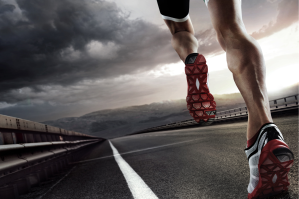
Get your FREE guide to Running Technique
What is Running Cadence?
Before you can improve your cadence, it's important to understand what it is. Cadence is the number of steps you take per minute while running. A higher cadence means taking more steps per minute, while a lower cadence means taking fewer steps per minute.
Speed, it is directly proportional to two variables, Stride Length and Cadence.
Running Speed = Stride Length X Cadence
Speed (meters/minute) =Stride Length (meters) Cadence (strides/minute)
Stride length is a function of force a runner generates when they hit the ground, while cadence is how quickly one repeats their stride. Cadence is easily measurable, with the help of a sports watch like a Garmin or Polar watch and by devices such as Stryd footpod. Improving cadence comes with the benefit of reducing injury rate which we cover later. Using sports watch or footpod you can start observing the correlation between your pace and cadence fairly easily. From the equation above we can see that increasing our run cadence will increase our speed – great news!
Elite Athlete Running Cadence Examples
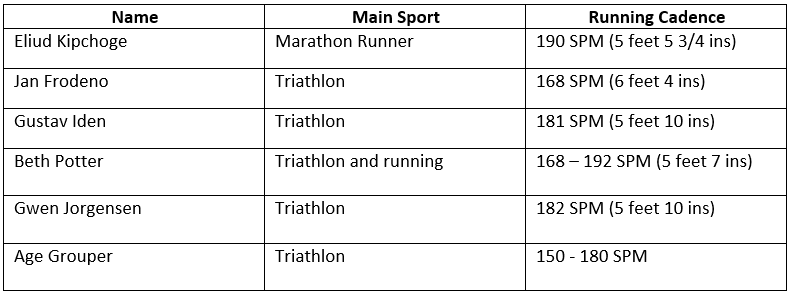
This table shows some examples of cadences of elite athletes and as you can see they vary and can be a function of height. For age group triathletes you cadence can be anything from 150 SPM upwards.
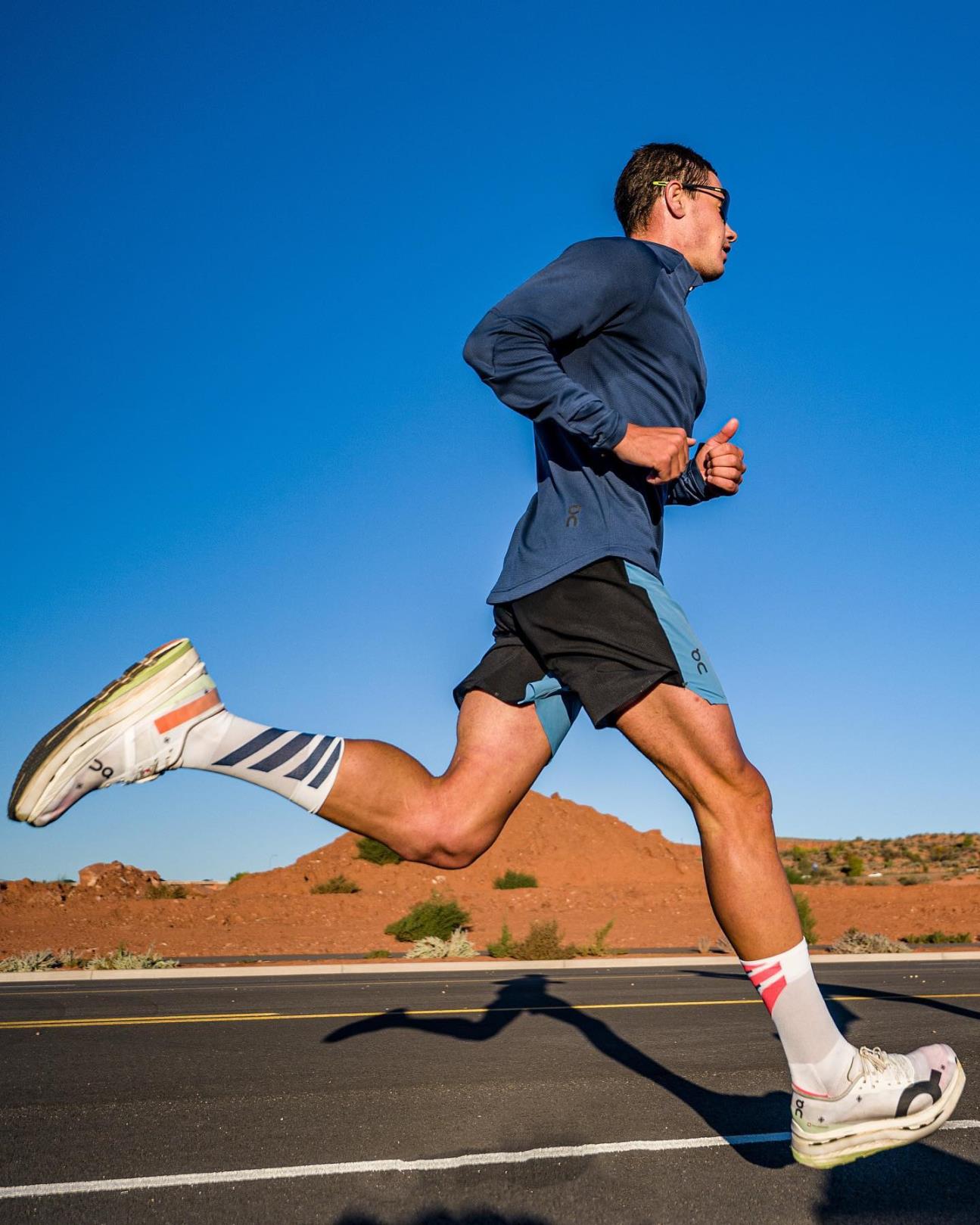
Gustav Iden's running technique
Get your FREE guide to Running Technique
Why do we want to Improve our Running Cadence?
Injury prevention
Increasing cadence results in less ground contact time and hence relatively less impact when landing with the feet, which in turn avoids common foot injuries.
Often the focus is on increasing stride length for speed, causing overstriding. Overstriding increases the impact on knee and ankle joints when landing and often leads to heavy landing on the heel causing various foot injuries. Increasing cadence reduces overstriding, thus helps in injury prevention. You should be aiming to land your foot under your hip rather than out in front.
Running Economy
Reduced impact on landing is also beneficial in improving running economy, which helps in conserving energy and endurance.
Increase in cadence has direct correlation with vertical bounce. Higher cadence reduces vertical bounce this in turn improves running economy. Quite a few stride sensors (Garmin, Stryd, etc.) help you measure vertical bounce.
Running Performance
Most importantly, increasing cadence and keeping the stride length can have significant improvement in pace. An illustration might help here:
- For a 60-minute 10k runner with a cadence of 165, stride length would be around 101 cm.
- Increasing the cadence by 5 strides to 170 while keeping the stride length at 101 cm, will cut the pace by 10 seconds per kilometre.
- That would bring the finish time to 58 minutes, a 2-minute improvement while giving other benefits.
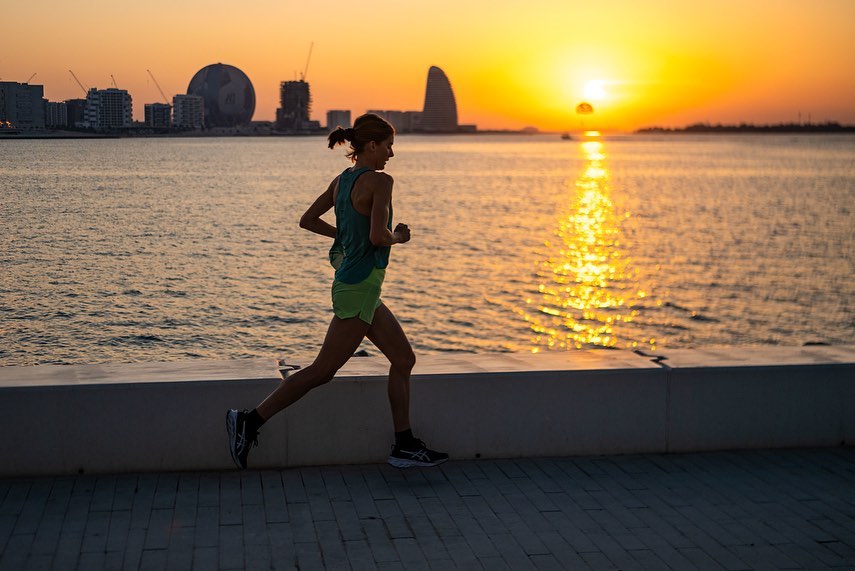
Beth Potter Running in Leeds
Get your FREE guide to Running Technique
Ways to Improve Running Cadence
Below is a step-by-step guide to improving your running cadence or steps per minute (SPM).
The First Step: Measuring your current Cadence
To improve your cadence, you first need to know what your current cadence is. There are many ways to measure cadence, but one of the easiest is to count the number of steps you take in one minute. You can do this by running on a treadmill and counting your steps for 60 seconds, or by using a running app that tracks your cadence. You can also record this during your next run on your Garmin, Polar or other sports watch or your Stryd or other footpod. (If you are interested in purchasing a Stryd footpod us the code coach-parnell to get 15% off).
As the management guru Peter Drucker famously said, “If you can't measure it, you can't manage it.” but luckily, we can measure it easily so take a look at your current running cadence using one of the techniques above as a first step to improving it.
Cadence is however very personal and can vary depending on your height, weight, fitness level and mobility plus in longer distance runs like those in IRONMAN 70.3 and IRONMAN races your cadence will probably decrease as you get near the end of the race due to fatigue.
The Second Step: Set a Goal Cadence
Once you know your current cadence, you can set a goal cadence to work towards. A good goal cadence for most runners is between 170 and 180 steps per minute. However, everyone is different, so you may need to adjust your goal cadence based on your individual needs and abilities.
Triathletes can see benefit in matching their run cadence to their optimum bike cadence and as luck would have it some studies have shown the optimum cycling cadence is 90 revolutions per minute (RPM) which happens to be 180 steps per minute (SPM) in running. But if your bike cadence is naturally 85 RPM then matching your run cadence to this which is 170 SPM maybe be a target you can set to make transitioning from the bike to run in T2 easier.
Set a goal of 5 to 10 strides on top of the current baseline or 5-10%. Anything significantly beyond can be counter-productive as it can negatively affect running economy.
For example, if you current running cadence is 160 SPM and you want to aim to increase this by 10% then your target would be 168 SPM over time.
Now we understand our current running cadence (plus probably our cycling cadence to match it to) how do we go about increasing our cadence?
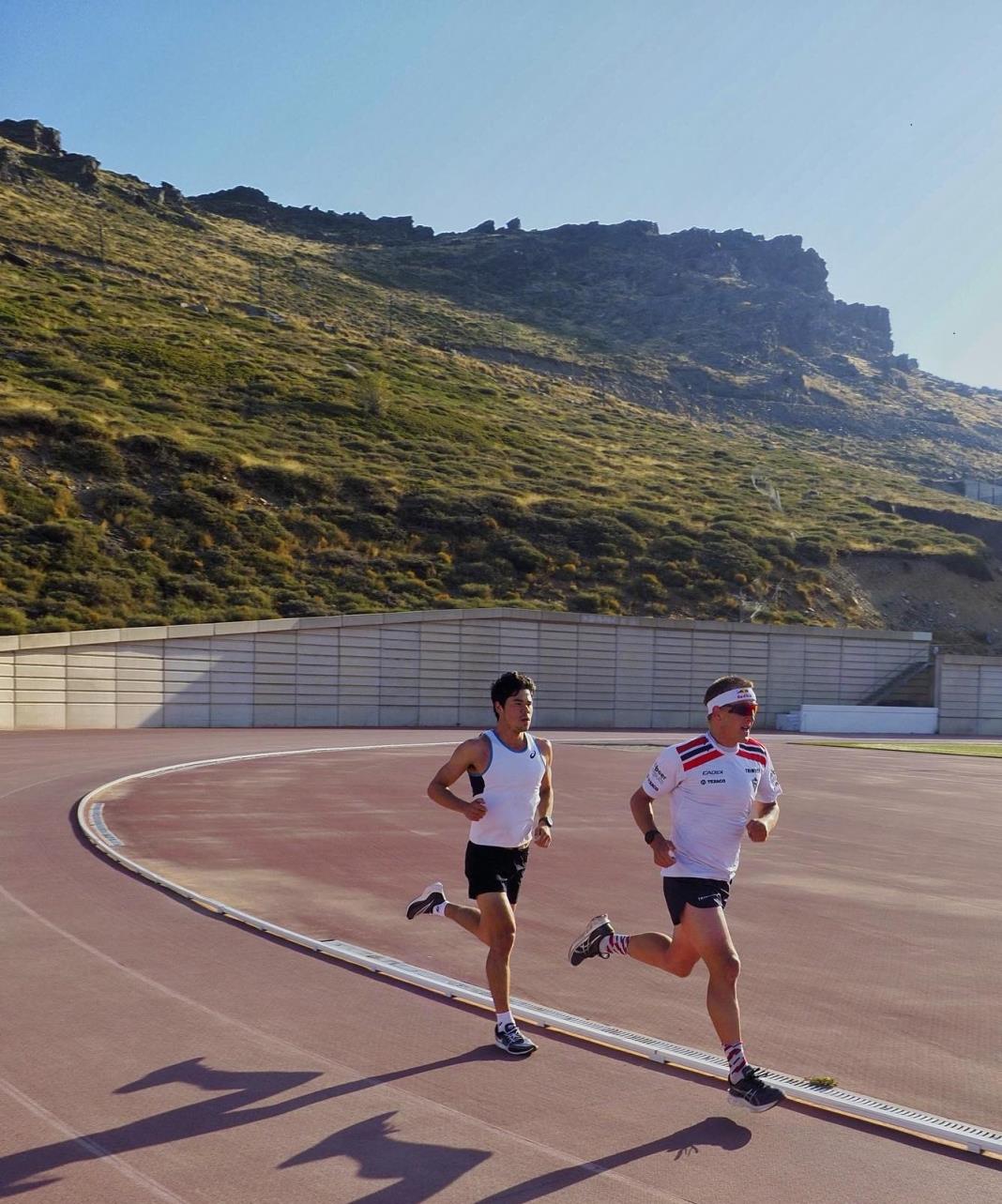
Kristian Blummenfelt and Gustav Iden running at the high altitude centre in Spain
Get your FREE guide to Running Technique
The Third Step: Select your Cadence Improvement Method
There are many methods of improving your running cadence and it will come down to which method appeals to you, the time you have to train, how important you feel it is to you and if you can stack the method into your training sessions. Adding the method into to a training session and creating a habit by stacking it to say your warmup will probably make your goal more achievable.
Training for cadence involves drills, specific and conscious form changes.
Methods to Improve Running Cadence
Running Workouts
1. Galloway’s Cadence Drill Workout
This is probably the most well-known cadence workout or drill, Coach Jeff Galloway’s Cadence Drill (CD). The idea behind this drill is to improve the coordination between feet, legs, nervous system, and our internal timing mechanism. CD involves the following steps:
- Start with a slow jog and then run for 30 seconds. During this half minute, count the number of times your left foot touches the ground.
- Take a recovery walk for a minute.
- Repeat the 30 second run for a second time, with every additional half minute, increase the cadence by a count of 2.
- Repeat this exercise 3-7 times.
This workout may be trying to force your cadence rate too quickly in a short space of time but it’s worth trying to appreciate your current cadence and what it feels like to run at a higher cadence.
2. Hill Repeats Workout
Hill repeats are a staple for cadence training and improving force generation. Running up the hill requires that fight gravity, and it is natural that we reduce the stride length and increase the cadence. Also, when we run up the hill, the distance the front foot travels downwards is lessened and we cannot fully extend our hip, knee and ankles easily. Hence it trains us to generate more force to get the full extension to run faster. Increased force generation will help in improved cadence and stride on level ground.
Here's an example of a hill repeats session:
- Warmup well
- Perform a short 30 second all out run up your chosen hill, with a recovery walk 30 seconds back down the hill then gentle jog to the start point.
- When you are fully recovered run up the hill for 45 seconds, stop walk back towards the start for 45 seconds and jog back the rest to the start point.
- Repeat the above 2-3 times.
Since hill repeats are very intense only do the sessions once a week. If you don’t live in a hilly area, you can do this session as fast intervals concentrating on pumping your arms and legs and a fast cadence.
3. Running with Metronome or Music
Using a metronome that is set to beats per minute (bpm) matching your target cadence and running to the beat is a classic method to improve running cadence. You can use a physical metronome, or a metronome app on your phone or smartwatch. Start by setting the metronome to your natural cadence plus two and try to match your steps to the beat. You can use a Finis Tempo Trainer Pro as a metronome as you run if you have one, just set it to Mode 3 and the cadence you want to achieve.
Alternative method that many use is to sync strides with music beats. There are several running apps and music playlists which can help with this.
Both methods work only on leg turn-over, hence not the best when compared to other methods. Running with just leg turnover as the focus, often results in reduced stride length which is not the aim of the game (remember the formula earlier).
Running Drills for Cadence Improvement
I like using the running drills method to help increase cadence as these drills can be added into your running warmup and thus part of every running session. Adding them in or stacking them into your warmup will over time become a habit and part of every run session which will reinforce higher cadence every time you prepare to run.
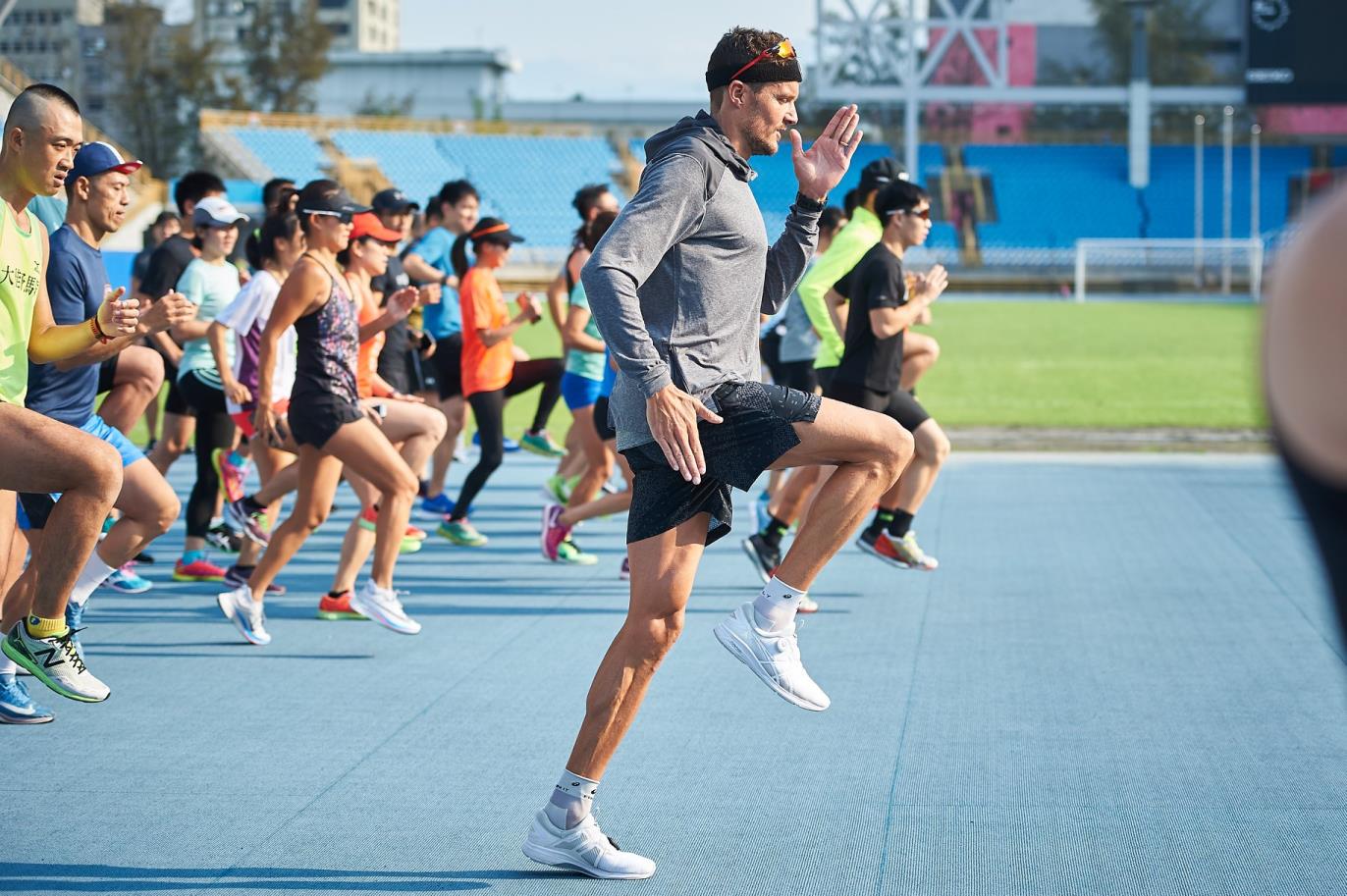
Jan Frodeno getting his running drill done
Get your FREE guide to Running Technique
A-Skips
This is one of my favourite drills. A-Skips involves learning to coordinate your legs and arms better, move the feet quickly and landing efficiently and stabilizing on midfoot. All of these movements will help in improving cadence.
High Knees
High knees is a useful drill to improve cadence. High knees will help in improving coordination between feet and arm movement, faster leg turn over and midfoot landing.
Agility Drills
Agility drills are very effective to improve coordination skills. Most long-distance runners don’t train for agility, and struggle with lack of coordination which often can also lead to injuries. Agility drills help in reducing Ground Contact Time (GCT) and improving leg turn over.
Fast Feet
To do the Fast Feet drill start with your feet hip or shoulder width apart and move your feet quickly in place raising through your mid-feet. Keep your body low through the drill. It primarily works on your leg speed. You can try different variations by moving your elbows in-sync with the feet.
Straight Leg Run
Straight-leg run is an excellent way to promote a mid-foot strike while practicing quick turnover and improving coordination. Keep your legs straight with no bend at knees and keep your toes pointing up run forward with landing on midfoot, while moving elbows in sync.
When performing these drills, it's important to focus on maintaining good form and technique. Keep your core engaged, your arms relaxed, and your feet landing softly. By incorporating these drills into your training routine, you can improve your running cadence and become a more efficient runner.
Biking Drills and Brick Sessions
Cyclists and triathletes are well known for working on bike Cadence to improve their speed and efficiency. Biking cadence drills can help with faster leg turnover. Standing on a stationary bike or a trainer with moderate-resistance and cycle at high cadence (aim for 90 RPM if you can) in intervals of 30 to 60 seconds duration with one-minute recovery. Alternative is to do seated biking with high-cadence bike intervals (100 RPMs) for up to five minutes with equal recovery. If you then add in a run off the bike as a Brick session you will be able to try to run at the same cadence plus also help to improve your bike to run transitions and get used to “wobbly legs”.
Ladder Drills
Ladder drills are like agility drills, with the added challenge of running on a ladder to work on coordination. These are very effective in reducing ground contact time and improving leg turn over. Here are some of the ladder drills that I recommend for cadence. You will need a ladder like this.
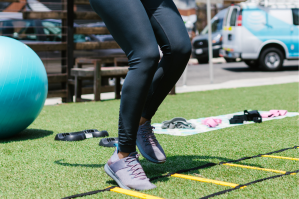
Ladder Agility Running Drill to improve Cadence
Get your FREE guide to Running Technique
Fast Feet on Ladder
Similar to Fast feet drill we saw earlier but doing it on a ladder.
Ladder In & Outs
Forward in & outs primarily works on improving the speed quads by working the adductors and abductors in quick succession.
How to Incorporate Drills
Here are some tips on how to incorporate running drills into a training program to improve running cadence:
Frequency
Running drills should be performed 1-2 times per week, ideally after a warm-up but before the main workout or run.
Timing
Running drills can be incorporated into various types of workouts, such as tempo runs, interval runs, or recovery runs. However, it is important to avoid doing the more strenuous running drills immediately before a race or a hard workout.
Progression
Start with basic running drills, such as high knees, butt kicks, or skipping. Once these drills can be done with good form, increase the duration or the speed of the drills, or add complexity with lateral movements, bounding, or agility drills. For example, start with 4-6 repetitions of each drill for 20-30 seconds, and gradually work up to 8-12 repetitions for 45-60 seconds.
Consistency
To see improvement in running cadence, it is important to perform running drills consistently over time. Make running drills a regular part of your training routine and aim to progress gradually and consistently.
Recovery
Some running drills and sessions such as hill repeats can be taxing on the body, so be sure to incorporate recovery time and rest days into your training program. It is also important to listen to your body and adjust the intensity or frequency of the drills as needed.
Skipping or Jump Rope
Skipping or jumping rope is great to improve your cadence, ground contact time (GCT) and cardiovascular capability. It’s also a great way to add plyometric training into your training week. Another advantage is that if you travel and can’t get out to run your can use this to get your run in, in a small space. Jump ropes are also very low cost and this is a great example.
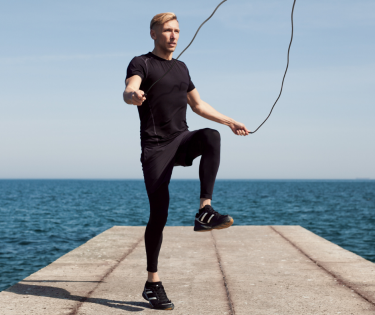
Jumping rope is great for improving running cadence
Get your FREE guide to Running Technique
Putting Higher Cadence into Action with Mindful Running
Training methods mentioned above will definitely help improve your cadence. However, when running longer runs or during races, often we switch back to our older levels of cadence that we are used to. This can happen during initial weeks of cadence training, as the cadence is not yet naturally adapted by the runner yet and you have not built your “muscle memory”.
Mindful running with Cadence will help. Here are some mental cues that you can use -
- Run a few high cadence (higher than your target cadence) strides before the long run. That will help in making you feel your target cadence much more natural.
- Running watches such as Garmin have the option to set target cadence. The watch will prompt if cadence levels drop below the target.
- Elbow movement and leg turnover are always in sync. Moving your elbows faster will always help you with higher cadence. I always say, “move your arms and your legs will follow”.
- Track your Cadence after every long run and see how the Cadence changes over the run. If there is a drop towards the later part of run, that is definitely an area you can work on to improve. This may be stamina or strength so start to identify which area you need to address.
For Races
During the last stages of the race if someone overtakes you, check if their legs are moving faster than yours, and you can try to match or beat their cadence. That is a great way to finish the race faster and stronger. Plus, don’t for get the high cadence sprint finish!
Cadence and Stride Length
Cadence and Stride length are two variables that will help with better running performance. As a runner, we would like to improve on both variables. Are there scenarios where we need to choose one over the other? A useful analogy is how car gears and acceleration work. When driving a car, using lower gear but higher acceleration when going uphills is most efficient, and when driving down a slope, using higher gear and lowering acceleration is sensible to do. Similarly running with a higher cadence when going uphills and using longer strides when going downhills is an efficient way to balance both. Building a good perception of what cadence, you are running at, is a useful skill for every runner to have.
Work on your Running Form
Improving your cadence is not just about taking more steps per minute - it's also about improving your overall form. Work on maintaining good posture, engaging your core, and keeping your arms relaxed and close to your body. Try not to forget your strength and conditioning and core strength sessions.
Many triathletes struggle with the term “running form” so here are some pointers:
- Head – looking forward, level with the horizon.
- Upper body – tall with a slight forward lean initiated from your ankle (don’t bend from the hip). Relaxed shoulders and neck muscles.
- Arm swing action – arms relaxed and bent, with a back and forward movement that helps promote thoracic rotation. You may have heard your running coach say “pocket to socket”. I.e., your hand should pass by your pocket, and come up toward your shoulder socket when you are running fast.
- Foot landing under your hip (rather than in front of you) and root your big toe and push off deep and powerfully and spring forward.
- Core engaged but not tight.
- Run tall – imagine a string from you head being pulled upwards and string from your chest being pulled forward.
- At the end of a long race think “bricks” imagine running over bricks so you lift your feet and knees higher to avoid the “IRONMAN shuffle”.
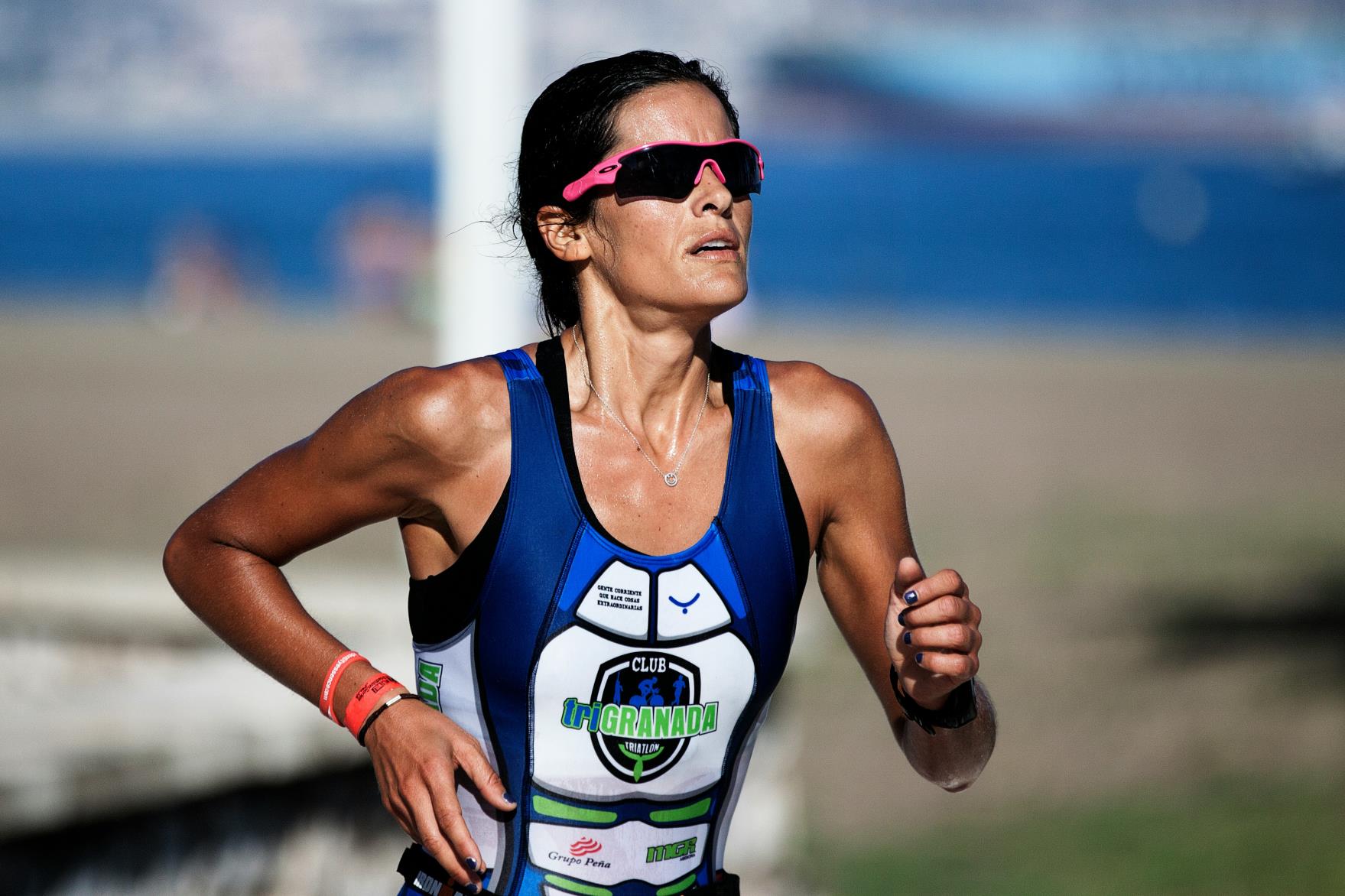
Get your FREE guide to Running Technique
Be Patient
Improving your cadence takes time and practice. Be patient with yourself and don't get discouraged if you don't see immediate results. Stick with it, and you'll eventually see improvements in your running form and efficiency.
Running Cadence is Individual
As mentioned before your cadence will be affected by your height, weight, fitness levels and mobility. There are other considerations such as:
Consider your Distance
For longer distance triathlons, a slightly lower cadence (around 170-175 steps per minute) may be more sustainable over the course of the race. However, for shorter distance triathlons, a higher cadence (around 180 steps per minute) may be more beneficial for increasing speed and efficiency.
Adjust for Terrain
Adjust your cadence based on the terrain you will be running on. For example, running uphill may require a higher cadence to maintain speed and efficiency, while running downhill may require a lower cadence to avoid overstriding.
Seek Guidance
If you're unsure of how to tailor your running cadence to your individual abilities and goals, consider seeking guidance from a coach or trainer who specializes in triathlon training.
By tailoring your running cadence to your individual abilities and goals, you can optimize your training and improve your performance in triathlons.
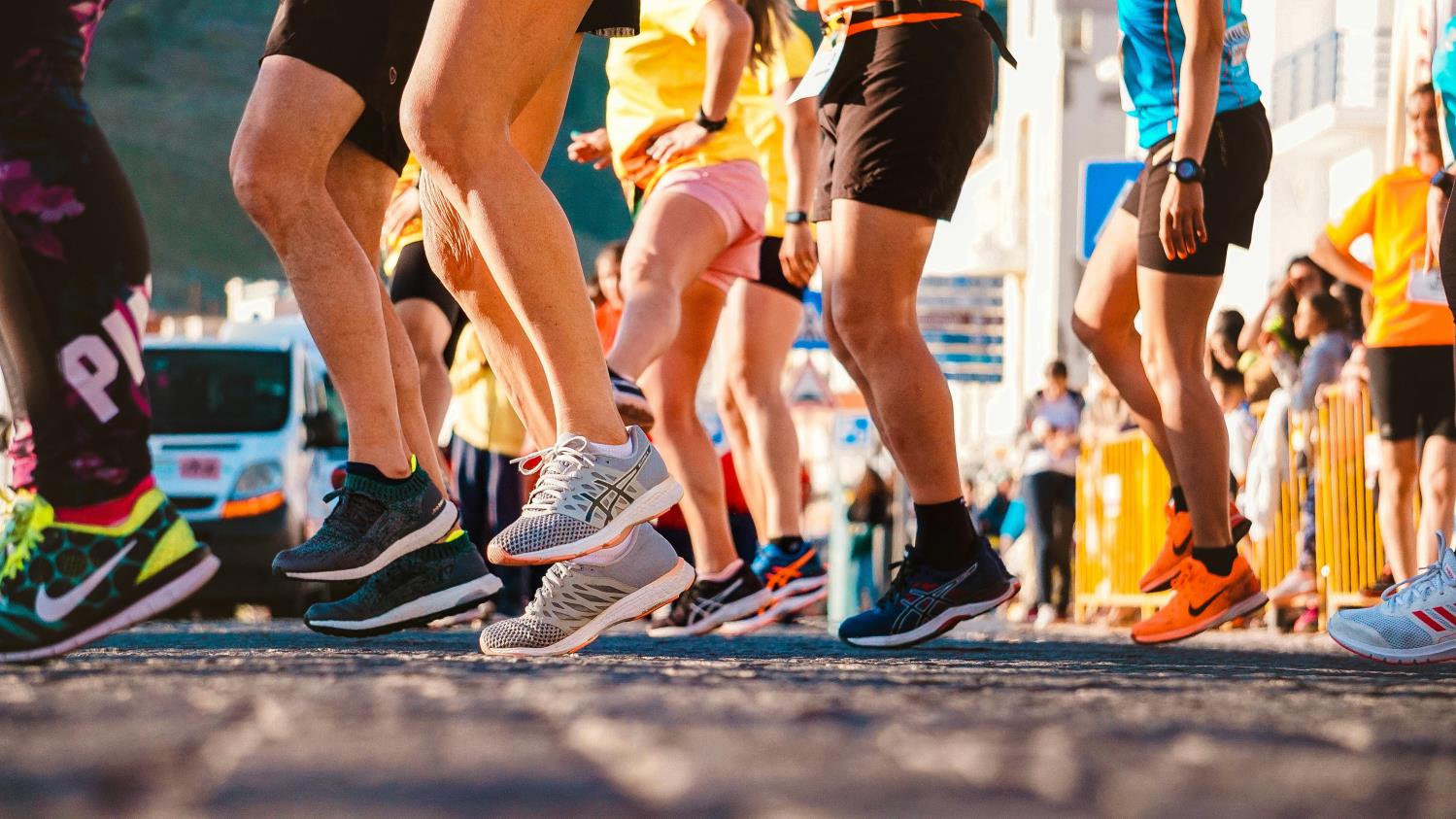
Get your FREE guide to Running Technique
Conclusion: Running Cadence
Each runner has a cadence that is optimal for them. By recording your current cadence and using a few simple cues around your stride length and form, you can increase your cadence to be more efficient and faster.
As you feel more comfortable with the new cadence, you can start training for the next level. But remember if you are already at your natural highest and don’t overstride, further increase in cadence might not be beneficial.
Your optimum cadence is personal to you so be wary of anyone stating 180 SPM as the “best” or “correct” cadence. This comes from the 1984 Olympics where famous coach Jack Daniels counted the strides of all of his elite distance runners and, of the 46 he studied, only one was under 180 SPM (176 SPM). Coach Daniels further noted that in his 20 years of coaching college students, not one was over 180 SPM. This study may be being taken out of context and even misquoted, stating all runners should be at 180 SPM which simply is not true.
In conclusion, improving your run cadence can help you run more efficiently and reduce your risk of injury. By following these tips and tricks, you can work towards a higher cadence and improve your overall running form and technique. Happy running!
Karen Parnell is a Level 3 British Triathlon and IRONMAN Certified Coach, 8020 Endurance Certified Coach, WOWSA Level 3 open water swimming coach and NASM Personal Trainer and Sports Technology Writer.
Karen is currently studying for an MSc in Sports Performance Coaching at the University of Stirling.
Need a training plan? I have plans on TrainingPeaks and FinalSurge:
I also coach a very small number of athletes one to one for all triathlon and multi-sport distances, open water swimming events and running races, email me for details and availability. Karen.parnell@chilitri.com
Get your FREE Guide to Running Speed and Technique
Get your FREE Swim Workouts for Triathletes E-book
Get your FREE Open Water Swimming Sessions E-Book
FAQ: Running Cadence
What is running cadence?
Running cadence refers to the number of steps you take per minute while running. A higher cadence generally means a quicker, more efficient stride.
Why is running cadence important?
Maintaining a high running cadence can help improve your running efficiency, reduce your risk of injury, and increase your speed and endurance.
What is a good running cadence?
A good running cadence is generally considered to be around 170-180 steps per minute, although this can vary depending on factors such as height, weight, and running experience.
What are some drills to improve running cadence?
Some effective drills to improve running cadence include high knees, butt kicks, skipping, fast feet, and strides.
How often should I do running drills to improve cadence?
It's generally recommended to do running drills once or twice per week as part of your regular training routine.
How can I use running cadence in triathlon training?
In triathlon, maintaining a high running cadence can be especially important, as it can help you conserve energy for the bike and run. Incorporating running drills and focusing on form can help improve your cadence and make you a more efficient runner.
How can I maintain a high running cadence during a triathlon?
One way to maintain a high cadence during a triathlon is to use a metronome or music with a steady beat to help keep your steps consistent. It's also important to focus on good form and avoid overstriding or landing heavily on your feet. Finally, practicing brick workouts (back-to-back bike and run sessions) can help prepare your legs for the unique demands of triathlon running.
References
Training for Cadence (geeksonfeet.com)
#running #runner #triathlon #triathlete #ironman #runcadence #runstride #runtraining #pacecalculator #heartrate #hr #traithlontrainingplans #runningtrainingplans #swimmingtrainingplans
